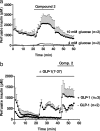Small-molecule agonists for the glucagon-like peptide 1 receptor
- PMID: 17213325
- PMCID: PMC1783418
- DOI: 10.1073/pnas.0605701104
Small-molecule agonists for the glucagon-like peptide 1 receptor
Abstract
The peptide hormone glucagon-like peptide (GLP)-1 has important actions resulting in glucose lowering along with weight loss in patients with type 2 diabetes. As a peptide hormone, GLP-1 has to be administered by injection. Only a few small-molecule agonists to peptide hormone receptors have been described and none in the B family of the G protein coupled receptors to which the GLP-1 receptor belongs. We have discovered a series of small molecules known as ago-allosteric modulators selective for the human GLP-1 receptor. These compounds act as both allosteric activators of the receptor and independent agonists. Potency of GLP-1 was not changed by the allosteric agonists, but affinity of GLP-1 for the receptor was increased. The most potent compound identified stimulates glucose-dependent insulin release from normal mouse islets but, importantly, not from GLP-1 receptor knockout mice. Also, the compound stimulates insulin release from perfused rat pancreas in a manner additive with GLP-1 itself. These compounds may lead to the identification or design of orally active GLP-1 agonists.
Conflict of interest statement
Conflict of interest statement: All of the authors (except J.J.H. and D.K.) are employees of pharmaceutical companies, which have a financial interest in this article. All authors except J.J.H. also have shares or stocks. J.J.H. is a consultant for Novo Nordisk.
Figures





Comment in
-
Nonpeptidic glucagon-like peptide 1 receptor agonists: a magic bullet for diabetes?Proc Natl Acad Sci U S A. 2007 Jan 16;104(3):689-90. doi: 10.1073/pnas.0610679104. Epub 2007 Jan 9. Proc Natl Acad Sci U S A. 2007. PMID: 17213306 Free PMC article. No abstract available.
References
-
- Kieffer TJ, Habener JF. Endocr Rev. 1999;20:876–913. - PubMed
-
- Nauck MA, Kleine N, Orskov C, Holst JJ, Willms B, Creutzfeldt W. Diabetologia. 1993;36:741–744. - PubMed
-
- Zander M, Madsbad S, Madsen JL, Holst JJ. Lancet. 2002;359:824–830. - PubMed
-
- During MJ, Cao L, Zuzga DS, Francis JS, Fitzsimons HL, Jiao X, Bland RJ, Klugmann M, Banks WA, Drucker DJ, et al. Nat Med. 2003;9:1173–1179. - PubMed
-
- Gros R, You X, Baggio LL, Kabir MG, Sadi AM, Mungrue IN, Parker TG, Huang Q, Drucker DJ, Husain M. Endocrinology. 2003;144:2242–2252. - PubMed
MeSH terms
Substances
LinkOut - more resources
Full Text Sources
Other Literature Sources
Chemical Information
Research Materials

